|
Believing the earth to be a globe,
Columbus expected to find India or Eastern Asia by sailing westward from
Spain. The first land discovered by him—one of the Bahama Islands—he
supposed to be a part of India, and he called the inhabitants Indians.
This name was afterwards applied to all the nations of the adjacent
islands and the continent.
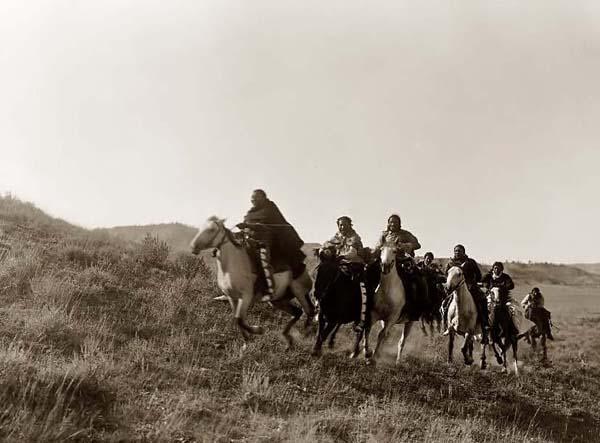
Indian Scouts
Origin.—There
is no positive knowledge concerning the origin of these of American
Natives; their own traditions widely vary, and conjecture is
unsatisfying. Recent investigations favor a theory that, if they be not
indigenous, they came from two great Asiatic families: the more northern
tribes of our continent from the lighter Mongolians, who crossed at
Bering Strait, and the more southerly ones, in California, Central and
South America, from the darker Malays, who first peopled Polynesia, in
the southern Pacific Ocean and finally made their way to our continent,
gradually spreading over it from the Pacific to the Atlantic. Language
fails to connect any of them with the Asiatic families, but their
traditions, implements, and modes of life point to such a relationship.
It has been suggested that the Mandans and Chinooks, who are almost
white, are descendants of a Welsh colony said to have been lost in the
wilds of North America 700 years ago.
Unity.—There
seems to be a physical identity of race throughout most of the
continent. Their skin is generally of a dark reddish-brown, or cinnamon,
color; they have long, black, and straight hair, prominent cheek-bones,
and broad faces; eyes deep-set, full and rounded lips, broad and
prominent noses, scanty beard; their heads are generally square, and
their stature about the same as that of other races of the same
latitude. Their muscular development is not great, and their hands and
feet are small; their skin is thinner, softer, and smoother than that of
Europeans; the expression of the men is often noble, and many of the
women are handsome. Haughty in deportment, taciturn, stoical, cunning,
persevering, brave and ferocious in war; cruel towards enemies and
faithful towards friends; grateful for favors, hospitable and kind.
Their mental temperament is poetic and imaginative in a high degree, and
it is often expressed in great beauty and eloquence of language. The
tribes south of California have always been noted for significant mental
development.
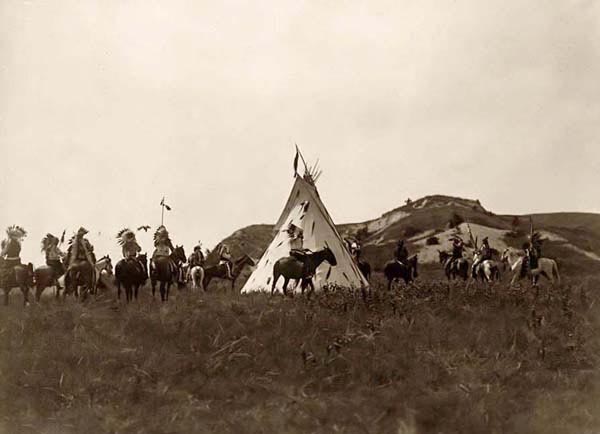
War Party
Pursuits.—War,
hunting, and fishing are the chief pursuits of the men of the warring
tribes; agriculture of the more domesticated. Among the Indians found in
North America by Europeans, the women performed almost all the manual
labor and burden-bearing. They carried on their limited agriculture,
which consisted in the production of maize or Indian corn, beans,
squashes, potatoes, and tobacco. They manufactured the implements of
war, and for hunting and fishing; made mats, and skin and feather
clothing, canoes, ornaments of the teeth and claws of beasts, and of
shells and porcupine-quills; performed all domestic drudgery, and
constructed the lodges of the bark of trees or the hides of beasts. Rude
figures of animate and inanimate objects carved in wood or stone, or
molded in clay, and picture-writing on the inner bark of trees or the
skins of beasts, or cut upon rocks, with rude ornamented pottery, were
the extent of their accomplishments in the arts of design and of
literature. The picture-writing was sometimes used in musical notation,
and contained the burden of their songs.
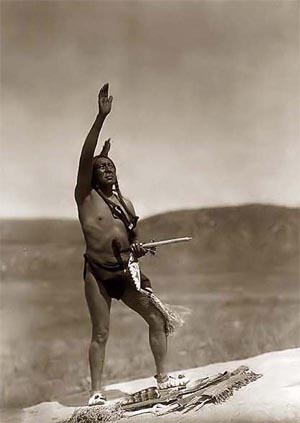 Religion.—They
believed in a good and Supreme Being, and in an Evil Spirit, and
recognized the existence of inferior good and evil spirits. They
believed in a future state of existence, and there were no infidels
among them. Superstition among swayed them powerfully, and special men,
called "medicine-men," were their physicians, priests, and prophets,
who, on all occasions, used incantations. Christian missionaries have
labored among them in many places, from the time the Spaniards and
Frenchmen settled in America until now. Religion.—They
believed in a good and Supreme Being, and in an Evil Spirit, and
recognized the existence of inferior good and evil spirits. They
believed in a future state of existence, and there were no infidels
among them. Superstition among swayed them powerfully, and special men,
called "medicine-men," were their physicians, priests, and prophets,
who, on all occasions, used incantations. Christian missionaries have
labored among them in many places, from the time the Spaniards and
Frenchmen settled in America until now.
Government.
— There was not a semblance of a national government among
the Indians when the Europeans came, except that of the
IROQUOIS
CONFEDERACY. Their language was varied by more than a hundred dialects,
and they were divided into many distinct families or tribes, under a
kind of patriarchal rule. Each family had its armorial sign, called a
totem, such as an eagle, a bear, or a deer, by which it was designated.
The civil head of a tribe was called a sachem, and the military leader a
chief. Those official honors were gained sometimes by inheritance, but
more frequently by personal merit. Such was the simple government,
seldom disobeyed, that controlled about 1,000,000 inhabitants of the
present domain of the United States, which extends over nearly
twenty-five degrees of latitude and about sixty degrees of longitude.
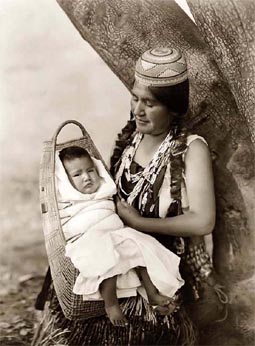 Geographical
Distribution.—There seem to have been only eight radically
distinct nations known to the earlier settlers—namely, the Algonquian,
Huron - Iroquois, Cherokee, Catawba, Uchee, Natchez, Mobilian or
Floridian, and Dakota or
Sioux. More recently, other distinct nations have been
discovered—namely, the Athabascas , Sahaptins, Chinooks, Shoshones, and
Attakapas. Others will doubtless be found. The Algonquians were a large
family occupying all Canada, New England, a part of New York and
Pennsylvania ; all New Jersey, Delaware, Maryland, and Virginia; eastern
North Carolina above Cape Fear, a large part of Kentucky and Tennessee,
and all north and west of those States east of the Mississippi. Within
the folds of this nation were the Huron-Iroquois, occupying a greater
portion of Canada south of the Ottawa River, and the region between Lake
Ontario and Lakes Erie and Huron, nearly all of the State of New York,
and a part of Pennsylvania and Ohio along the southern shores of Lake
Erie. Detached from the main body were the Tuscaroras and a few smaller
families dwelling in southern Virginia and the upper part of North
Carolina. Five families of the Huron-Iroquois, dwelling within the
limits of the State of New York, formed the famous
Iroquois Confederacy
of Five Nations. The
Cherokees inhabited the fertile and picturesque
region where the mountain ranges that form the watershed between the
Atlantic and Mississippi melt in the lowlands that border the Gulf of
Mexico. The Catawbas were their neighbors on the east, and dwelt upon
the borders of the Yadkin and Catawba rivers, on both sides of the
boundary-line between North and South Carolina. The Uchees were a small
family in the pleasant land along the Oconee and the head-waters of the
Ogeechee and Chattahoochee, in Georgia, and touched the Cherokees. They
were only a remnant of a once powerful tribe, when the Europeans came,
and they claimed to be more ancient than the surrounding people. The
Natchez occupied a territory on the eastern side of the Mississippi,
extending northeastward from the site of the city of Natchez along the
Pearl River to the head-waters of the Chickasaw. They claimed to be
older than the Uchees, and, like others of the Gulf region, they
worshipped the sun and fire, and made sacrifices to the source of
terrestrial light. The Mobilians or Floridians occupied a domain next in
extent to that of the Algonquians. It stretched along the Atlantic coast
from the mouth of the Cape Fear River to the extremity of the Florida
peninsula, and westward along the Gulf of Mexico about 600 miles to the
Mississippi River. They also held jurisdiction up that stream as far as
the mouth of the Ohio. The domain included parts of South Carolina, the
whole of Florida, Alabama, and Mississippi, all of Georgia not occupied
by the Cherokees and Uchees, and portions of Tennessee and Kentucky. The
nation was divided into three confederacies, each powerful and
independent, like our separate States. They were known respectively as
the Muscogee or Creek (the most powerful), the Choitan, and the
Chickasaw. The heart of the Creek family was in Alabama. Geographical
Distribution.—There seem to have been only eight radically
distinct nations known to the earlier settlers—namely, the Algonquian,
Huron - Iroquois, Cherokee, Catawba, Uchee, Natchez, Mobilian or
Floridian, and Dakota or
Sioux. More recently, other distinct nations have been
discovered—namely, the Athabascas , Sahaptins, Chinooks, Shoshones, and
Attakapas. Others will doubtless be found. The Algonquians were a large
family occupying all Canada, New England, a part of New York and
Pennsylvania ; all New Jersey, Delaware, Maryland, and Virginia; eastern
North Carolina above Cape Fear, a large part of Kentucky and Tennessee,
and all north and west of those States east of the Mississippi. Within
the folds of this nation were the Huron-Iroquois, occupying a greater
portion of Canada south of the Ottawa River, and the region between Lake
Ontario and Lakes Erie and Huron, nearly all of the State of New York,
and a part of Pennsylvania and Ohio along the southern shores of Lake
Erie. Detached from the main body were the Tuscaroras and a few smaller
families dwelling in southern Virginia and the upper part of North
Carolina. Five families of the Huron-Iroquois, dwelling within the
limits of the State of New York, formed the famous
Iroquois Confederacy
of Five Nations. The
Cherokees inhabited the fertile and picturesque
region where the mountain ranges that form the watershed between the
Atlantic and Mississippi melt in the lowlands that border the Gulf of
Mexico. The Catawbas were their neighbors on the east, and dwelt upon
the borders of the Yadkin and Catawba rivers, on both sides of the
boundary-line between North and South Carolina. The Uchees were a small
family in the pleasant land along the Oconee and the head-waters of the
Ogeechee and Chattahoochee, in Georgia, and touched the Cherokees. They
were only a remnant of a once powerful tribe, when the Europeans came,
and they claimed to be more ancient than the surrounding people. The
Natchez occupied a territory on the eastern side of the Mississippi,
extending northeastward from the site of the city of Natchez along the
Pearl River to the head-waters of the Chickasaw. They claimed to be
older than the Uchees, and, like others of the Gulf region, they
worshipped the sun and fire, and made sacrifices to the source of
terrestrial light. The Mobilians or Floridians occupied a domain next in
extent to that of the Algonquians. It stretched along the Atlantic coast
from the mouth of the Cape Fear River to the extremity of the Florida
peninsula, and westward along the Gulf of Mexico about 600 miles to the
Mississippi River. They also held jurisdiction up that stream as far as
the mouth of the Ohio. The domain included parts of South Carolina, the
whole of Florida, Alabama, and Mississippi, all of Georgia not occupied
by the Cherokees and Uchees, and portions of Tennessee and Kentucky. The
nation was divided into three confederacies, each powerful and
independent, like our separate States. They were known respectively as
the Muscogee or Creek (the most powerful), the Choitan, and the
Chickasaw. The heart of the Creek family was in Alabama.
Under the general title of Dakotas or
Sioux have been grouped a large number of tribes west of the Great Lakes
and Mississippi, with whom the earlier French
explorers came in contact.
These, speaking dialects of the same language, apparently, were regarded
as parts of one nation. They inhabited the domain stretching northward
from the Arkansas River to the western tributary of Lake Winnipeg, and
westward along all that line to the eastern slope of the Rocky
Mountains. They have been arranged into four classes: 1. The Winnebagoes,
situated between Lake Michigan and the Mississippi, within the domain of
the Algonquians. 2. The Assiniboins, or
Sioux proper, who formed the more northerly part of the nation. 3.
The Southern Sioux, who were seated in the country between the Platte
and Arkansas rivers. 4. The Sahaptins include the Nez Perces and
Walla Wallas, extending from the Rocky Mountains to the Pacific Ocean,
in Oregon and Washington. Beyond these are the more powerful Chinooks.
They embraced numerous tribes, from the mouth of the Columbia River to
the Grand Dalles. The Shoshones comprise tribes inhabiting the territory
around the head-waters of the Columbia and Missouri rivers; the
Comanches, extending from the headwaters of the Brazos to those of the
Arkansas; families in Utah and Texas, and several tribes in California.
The Attakapas and Chitemachas, in Texas, have languages that enter into
no known group.
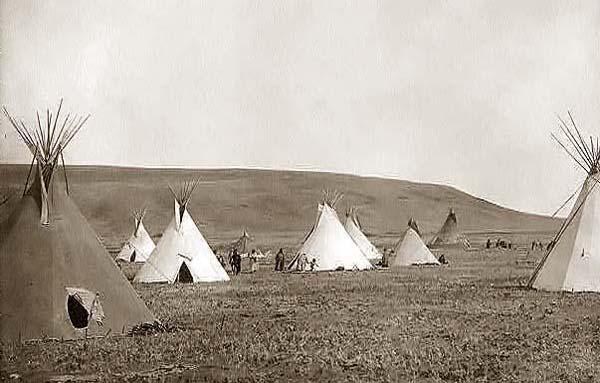
Indian Camp
Condition of the
Indians.—According to official reports, the Indian population
in 1904 was, approximately, about 270,000, nearly all of whom were
partially or absolutely under the control of the national government.
There were 180,000 Indians on reservations, or at schools under control
of the Indian Bureau, leaving about 90,000 in the five civilized tribes
of Indian Territory and in New York State, the former numbering about
84,500, and the latter, 5,232. Besides these, there were 32,567 taxable
and self-sustaining Indians who had become citizens of the United
States. The expensive and complicated machinery for the management of
Indian affairs has been much in the way of the elevation of the race in
the scale of civilization, and has produced much evil by creating
irritation, jealousy, and universal lack of faith in the white race.
These irritations for a long time kept a large portion of the Indians in
a state of chronic hostility, and whole tribes utterly refused all
overtures of the government to accept its protection and fostering care.
In 1880 it was estimated that the number of potentially hostile Indians
was fully 60,000. In 1891 the condition of affairs had been much
improved. Among many tribes the introduction of agriculture, schools,
and churches had been attended with the happiest results. There were
24,357 pupils enrolled in the reservation, non-reservation, and day
schools, besides 3,506 in institutes and public schools, and these
schools were supported at an expense of $3.522,950. There is a tendency
in most of the tribes to engage in settled pursuits and accept
citizenship. See also names of various tribes.
As you study the resources on this site,
I invite you to keep the following in mind. The Indians, or Native
Americans were here first. This land was their land; they lived on
it, lived off it, and respected it. The
Westward Expansion of the United States effectively destroyed their
territory, and their way of life. Perhaps most disturbing . . . we
destroyed their way of life, without welcoming them into our way of
life. We isolated them on Indian Reservations, and did not
effectively invite them them into our culture. The scars of these
mistakes are still painfully visible today in the Indian culture. |